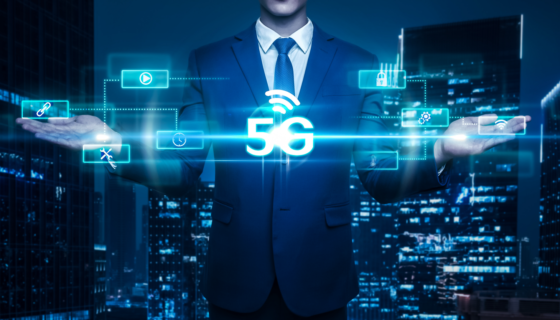5G Is Far Bigger Than Faster Smartphones

The world has never experienced as much uncertainty as it has today. The global pandemic has disrupted business, government, healthcare, and education on a global level. This extreme disruption is far more than institutional. It's been personal, disrupting how we all live, work, and play.
At the same time, because businesses and organizations of all sizes were forced to change, technological innovation has been accelerating beyond exponential levels, jumping ahead five and, in some cases, ten years or more in a matter of months, creating massive new opportunities that crisis managers are failing to notice.
For example, 5G is a transformational jump ahead and it's happening now, yet most will miss the multibillion-dollar opportunity 5G represents because we think we know what it is and what it does. Think again!
In order to see the magnitude of the opportunity I'm about to cover, it's important to start by adjusting our mindset.
Understanding and Leveraging Trends
Let's face it. It's easy to look at game-changing new technologies such as 5G and decide it's safer to wait and see what will happen and how others might use them. But in this new world of hyper-disruption, you will either be the disrupted or the disruptor; there is no in-between. Having a wait-and-see strategy can put you out of business fast. Worse yet, it can put you out of business slowly as you become increasingly less relevant as others rapidly pass you by. So what should you do? Focus on what you can be certain about!
Strategy based on uncertainty has high risk; that's why so many wait when it comes to applying new technologies. On the other hand, strategy based on certainty has low risk and high reward. When people have high levels of certainty, they have the confidence to make bold moves, and they know if they don't actively innovate, others will.
But how can we have the confidence to leverage technologies such as 5G and others, and better yet, how exactly do we identify these certainties? This is where my Hard Trend Methodology comes into play.
All trends fall into one of two categories: They are either Hard Trends that are based on future facts that will happen, or they are Soft Trends that are based on assumptions of what might happen. And when you attach a strategy to either a Hard Trend or Soft Trend, it bursts into actionable life.
The advantage of a Soft Trend is that it can be changed. The advantage of a Hard Trend is that you can identify disruptions before they disrupt and create a strategy to become a positive disruptor, creating the transformations that need to happen to increase your relevance and competitive advantage. This simple yet powerful methodology has transformed planning, innovation, and risk management for hundreds of innovative companies worldwide.
5G as a Hard Trend
There are several categories of Hard Trends, but the most powerful is technology. 5G is not only a Hard Trend future fact that will happen, but it represents a transformational platform for the creation of unlimited new products and services.
When 4G was introduced, within only a few years, new, multibillion-dollar businesses were born thanks to the new capabilities of 4G over 3G.
What is happening right now is even bigger! 5G is a transformational jump ahead. Within 24 to 48 months, new multibillion-dollar businesses will form, tapping into 5G's new revolutionary capabilities.
At this point, 5G is already available and rapidly growing on a global scale, starting in the largest cities where most businesses and people are. And with smartphone manufacturers now offering 5G versions of their phones, 5G usage will rapidly increase in dense populations and will spread outward from there. The businesses that get ahead of the curve will be best placed to reap the benefits.
It's important to understand that we will all benefit from 5G with faster downloads, enhanced video streaming and video conferencing, as well as new virtual experiences.
But in the short term, 5G will be transformative for asset-intensive, data-driven industries that depend on ubiquitous connectivity to support their 24/7 operations.
Over the years I've written about what's called Industry 4.0, in which autonomous robotics, machine-to-machine connected intelligence, and A.I.-enabled augmented thinking, to name a few, are now using 5G to elevate and accelerate the transformation of systems and practices. Across sectors including manufacturing, mining, energy, transportation, and smart city initiatives, there is an increased demand for bandwidth, minimal latency, and enhanced security, and leading businesses are already benefiting from 5G private wireless networks.
Because 5G dramatically elevates the capabilities of video conferencing, augmented reality (AR), virtual reality (VR), the Internet of Things (IoT), artificial intelligence as a service (AIaaS), autonomous vehicles, telesales, telehealth including remote diagnostics and surgery, and much more, multi billion-dollar companies that do not exist today will form within 48 months.
Don't Say "No" To 5G
5G is not the communications infrastructure of the future. In many critical ways, it has already arrived, and the businesses that are harnessing its power have started to race ahead.
Yet Nokia's 5G Readiness Report, which I highly recommend, found that only 15% of enterprises are currently investing in 5G implementation and 57% plan to invest within the next five years. In other words, they will miss one of the biggest opportunities of the decade.
Another interesting statistic in the report shows that 50% of companies are at the midway level on 5G readiness. In other words, they are getting ready to use 5G - in some form - as an engine for growth. Meanwhile, those already applying it or looking to expand further are growing considerably faster than their peers. Clearly, being ready to apply 5G to grow is very different than applying 5G to grow now.
In the past, the cost of saying "no" to technology-enabled innovation was relatively cheap; after all, the pace of digital disruption was relatively slow. Today, the risk of saying no, or waiting to see what will happen when faced with the certainty of 5G's exponential growth, means a loss of relevance and of competitive advantage. My advice: don't miss one of the biggest opportunities of the decade.









